| Poźniak | |
|---|---|
 | |
| Details | |
| Battle cry | - |
| Alternative names | Przestrzal |
| Earliest mention | unknown |
| Towns | none |
| Families | 6 surnames altogether: Apoznański, Poslewicz, Poślewicz, Poźniak, Poźniakowski, Pracki |
Poźniak or Przestrzał is a Polish coat of arms.
| Poźniak | |
|---|---|
 | |
| Details | |
| Battle cry | - |
| Alternative names | Przestrzal |
| Earliest mention | unknown |
| Towns | none |
| Families | 6 surnames altogether: Apoznański, Poslewicz, Poślewicz, Poźniak, Poźniakowski, Pracki |
Poźniak or Przestrzał is a Polish coat of arms.
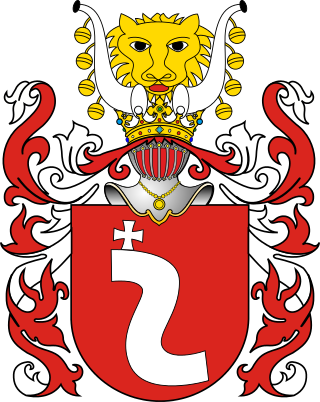
Srzeniawa is a Polish coat of arms. It was used by several szlachta families in the times of the Kingdom of Poland and the Polish–Lithuanian Commonwealth.

Ogończyk is a Polish coat of arms. It was used by several szlachta families in the times of the Kingdom of Poland and the Polish–Lithuanian Commonwealth.

Łodzia is a Polish coat of arms. It was used by many noble families of the Kingdom of Poland and the Polish–Lithuanian Commonwealth. A variant serves as the coat of arms of the city of Łódź. It's a classic example of the so-called canting arms well known in European heraldry as it was borne by the medieval lords de Łodzia and their clan. Hence the boat in the shield, clearly alluding to the estate's name literally meaning Boat. Coats of Arms in the Polish Lithuanian Commonwealth were a symbol of a heraldic clan.
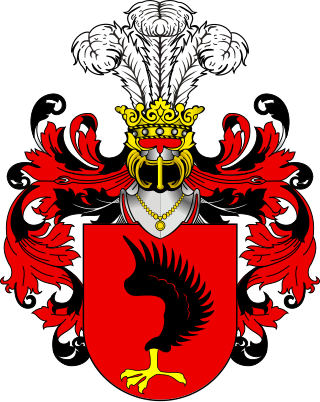
Kopacz is a Polish coat of arms. It was used by several szlachta families in the times of the Kingdom of Poland and Polish–Lithuanian Commonwealth.

Polish heraldry is the study of the coats of arms that have historically been used in Poland and the Polish–Lithuanian Commonwealth. It treats of specifically Polish heraldic traits and of the Polish heraldic system, contrasted with heraldic systems used elsewhere, notably in Western Europe. Due to the distinctive ways in which feudal societies evolved, Poland's heraldic traditions differ substantially from those of the modern-day German lands and France.
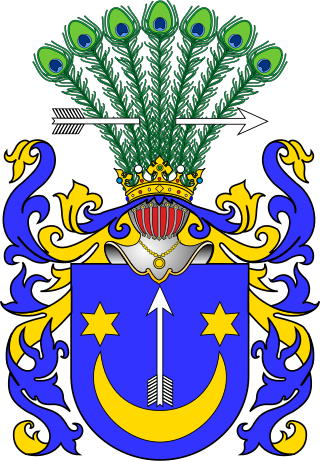
Sas or Szász is a Central European coat of arms. It was borne since the medieval period by several Transylvanian-Saxon Hungarian, Ruthenian, Ukrainian, and Polish-Lithuanian noble families. The house was once a mighty princely and ducal house with origins in Saxony, Transylvania, Hungary and Ruthenia.

Alabanda is a Polish nobility coat of arms, used by several szlachta families in the times of the Kingdom of Poland.
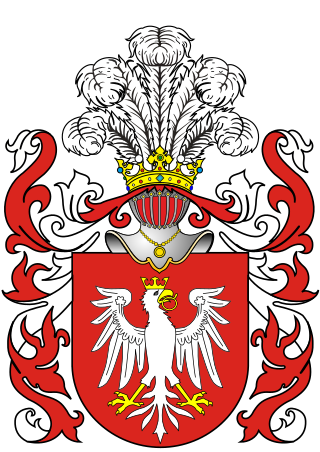
Amadej is a Polish coat of arms. It was used by several szlachta families in the times of the Kingdom of Poland and the Polish–Lithuanian Commonwealth.

Cholewa is a Polish coat of arms. It was used by several szlachta families in the times of the Polish–Lithuanian Commonwealth.

Grabie is a Polish coat of arms. It was used by many szlachta (noble) families in the Kingdom of Poland and later also in the Polish–Lithuanian Commonwealth, including the Grabias which is the Lithuanised form of the original Grabie coat of arms and name.

Orla is a distinct Polish armorial estate and heraldic clan coat of arms adopted in Polish heraldry since the Crown of the Kingdom of Poland. It was vested upon several knightly families of Poland's nobility situated in the historical region of Greater Poland, Silesia and Lesser Poland from about the 14th century, where it was first historically known in Poland as the coat of arms of 'Saszor' [Szaszor], later 'Orla', and subsequently conferred on the ennoblement of several individuals.

Bajbuza is a Polish coat of arms. It was used by several szlachta families in the times of the Polish–Lithuanian Commonwealth.

Bełty is a Polish coat of arms.

Bes(Bies, Bees, Beess) is a Polish coat of arms.

Piłsudski is a Polish coat of arms. The Piłsudski family, whom belonged to the Polish nobility (szlachta), used it.
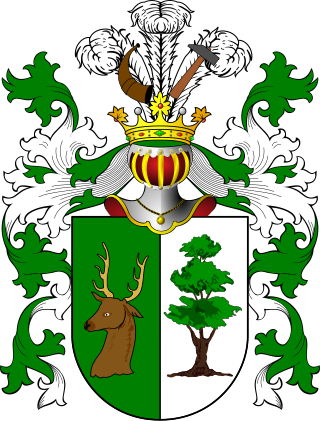
Grabowiec is a Polish coat of arms.

Alemani is a Polish nobility coat of arms originated from Italy.
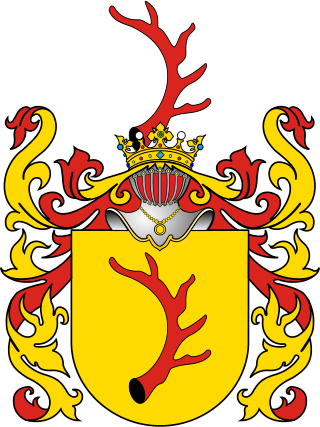
Biberstein is a Polish coat of arms. It was used by several szlachta families in the times of the Kingdom of Poland and the Polish–Lithuanian Commonwealth.

Heraldic adoption was in the Kingdom of Poland a legal form of ennoblement and adoption into an existing heraldic clan along with assuming the coat of arms of that clan. It took place as a result of an act issued by the King. The adoption of heraldic arms was a procedure used solely in Polish heraldry and was one of the earlier "old way" forms of ennoblement in Poland. It became particularly popular in the 15th century, especially with prosperous or prestigious city burghers and patricians aspiring to attain noble status, but was abolished by the first half of the 17th century.

A heraldic clan, in Poland, comprised all the noble (szlachta) bearers of the same coat of arms. The members of a heraldic clan were not necessarily linked by consanguinity. The concept was unique to Polish heraldry.